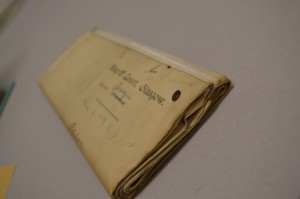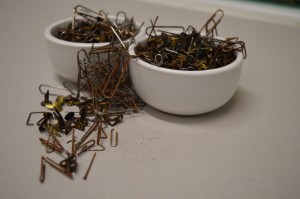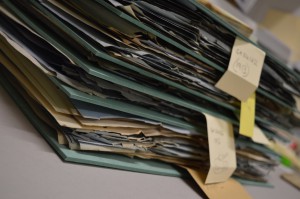Kat Saunt and Erika Freyr have just started working in the University Archives. They are assisting Elizabeth Yamada in the Wellcome Trust funded project to conserve the records of the Royal Scottish National Hospital.

The work placements have been designed for recent graduates or those about to apply for courses in conservation. They are intended to provide valuable experience of working in an archive on a large scale project in an academic environment.

The work requires a very high level of manual dexterity due to the degraded condition of the paper records. Each case file has to be carefully unfolded by hand before being flattened and cleaned, so that crucial repairs can be done. The aim is to stabilise the documents so that they can be safely handled by researchers and archivists.
One difficult aspect of this project is the sheer volume of paper to be treated over just ten weeks. This time constraint means that objects are treated according to their condition, and not all damage will be addressed. The goal in archive conservation is to protect the integrity of the data on each object rather than treating the aesthetics. This means that treatment is limited to dry cleaning and mending of tears. More extensive repairs, washing or alkalising can be done at a later stage if necessary, but would be beyond the remit of a project such as this.
Time management and allocation of resources is a constant consideration. For example, with a limited supply of pressing boards, some boxes of files are being cleaned while others are still flattening, so it is important to be mindful of the order in which the work is completed.

Almost all of the case files were held together with metal fixings which rust. Rust causes a chemical reaction in the paper which destroys the structural integrity of the sheet. Each fixing must therefore be removed, which is a delicate and time consuming task. (If fixings are necessary, brass is ideal. Please keep your future conservators in mind as you file!)
Once flattened, the sheets are cleaned using a latex chemical sponge. Dirt adheres to the latex better than to the paper and so it is lifted away without the need for abrasion. This is much gentler than using an eraser and much more effective than using a brush, giving the best cleaning result with the least risk to the very brittle paper.

The next step will be to start the process of repairing and rehousing the cleaned paper files. This will be the subject for a later blog.
